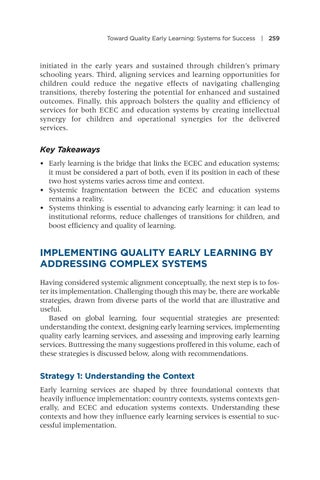Toward Quality Early Learning: Systems for Success | 259
initiated in the early years and sustained through children’s primary schooling years. Third, aligning services and learning opportunities for children could reduce the negative effects of navigating challenging transitions, thereby fostering the potential for enhanced and sustained outcomes. Finally, this approach bolsters the quality and efficiency of services for both ECEC and education systems by creating intellectual synergy for children and operational synergies for the delivered services.
Key Takeaways • Early learning is the bridge that links the ECEC and education systems; it must be considered a part of both, even if its position in each of these two host systems varies across time and context. • Systemic fragmentation between the ECEC and education systems remains a reality. • Systems thinking is essential to advancing early learning: it can lead to institutional reforms, reduce challenges of transitions for children, and boost efficiency and quality of learning.
IMPLEMENTING QUALITY EARLY LEARNING BY ADDRESSING COMPLEX SYSTEMS Having considered systemic alignment conceptually, the next step is to foster its implementation. Challenging though this may be, there are workable strategies, drawn from diverse parts of the world that are illustrative and useful. Based on global learning, four sequential strategies are presented: understanding the context, designing early learning services, implementing quality early learning services, and assessing and improving early learning services. Buttressing the many suggestions proffered in this volume, each of these strategies is discussed below, along with recommendations.
Strategy 1: Understanding the Context Early learning services are shaped by three foundational contexts that heavily influence implementation: country contexts, systems contexts generally, and ECEC and education systems contexts. Understanding these contexts and how they influence early learning services is essential to successful implementation.




